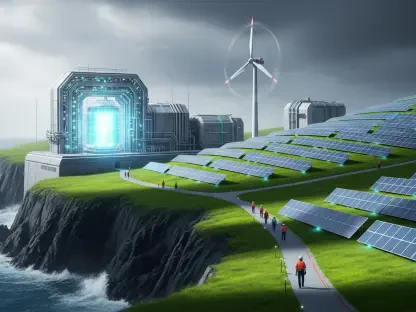Imagine a world where every household and business can monitor electricity usage in real-time, slashing costs and curbing environmental impact with pinpoint accuracy, while smart electric meters serve as the backbone of a revolutionized energy landscape. These advanced devices go beyond traditional metering by offering data-driven insights and seamless connectivity, enabling both consumers and utility providers to make informed decisions. With the global market for these meters projected to grow from USD 4.35 billion in 2025 to USD 8.75 billion by 2035 at a compound annual growth rate (CAGR) of 7.3%, their significance cannot be overstated. This remarkable expansion highlights a collective push toward energy efficiency, sustainability, and grid modernization amid pressing environmental challenges and aging infrastructure. As cities evolve into smarter ecosystems and renewable energy gains traction, smart meters are poised to redefine how electricity is managed and consumed on a global scale.
The Technology Behind the Transformation
Revolutionizing Energy with IoT and AI
Smart electric meters are being transformed by cutting-edge technologies such as the Internet of Things (IoT), artificial intelligence (AI), and cloud computing, creating a new era of energy management. These innovations allow for precise, real-time monitoring of electricity consumption, giving users the ability to track and adjust usage patterns instantly. IoT integration ensures that meters communicate seamlessly with other connected devices, while AI analyzes data to predict maintenance needs and optimize energy distribution. This synergy not only enhances the functionality of the meters but also supports broader sustainability goals by reducing waste. Utility providers benefit from actionable insights that improve operational efficiency, while consumers gain tools to lower their bills through informed choices. As these technologies continue to evolve, their role in driving the adoption of smart meters will become even more critical, shaping a future where energy systems are both intelligent and responsive to user needs.
Another key aspect of this technological revolution is the integration of smart meters with smart home systems, fostering greater consumer engagement. Cloud computing plays a pivotal role by enabling secure storage and analysis of vast amounts of energy data, allowing for remote access and control. This means households can manage their energy consumption from anywhere, aligning usage with off-peak rates or renewable energy availability. Furthermore, AI-driven analytics help identify inefficiencies and suggest tailored solutions, empowering users to make impactful changes. The compatibility of smart meters with renewable energy platforms, such as solar or wind systems, also addresses the challenge of variable energy supply by balancing loads in real-time. This level of sophistication marks a significant departure from traditional metering, positioning smart meters as essential components in the transition to cleaner, more sustainable energy practices over the next decade.
Enhancing Grid Resilience and Efficiency
Advanced Metering Infrastructure (AMI) is at the heart of how smart meters are strengthening grid resilience and efficiency across the globe. This technology enables two-way communication between utilities and consumers, eliminating the need for manual meter readings and ensuring more accurate billing processes. By providing real-time data on energy usage, AMI allows utilities to detect outages or anomalies swiftly, reducing downtime and enhancing service reliability. The reduction in operational costs for providers is substantial, as automated systems minimize labor-intensive tasks. For consumers, this translates into a more transparent and responsive energy experience, with immediate access to usage information. As grids modernize to accommodate growing demand, AMI-equipped smart meters will be instrumental in maintaining stability and efficiency, ensuring that energy networks can adapt to the complexities of modern consumption patterns by 2035.
Beyond operational improvements, smart meters significantly contribute to the integration of distributed energy resources into existing grids, a critical step for future energy systems. They provide the data needed to balance supply and demand, especially as renewable sources like solar and wind become more prevalent with their inherent variability. This capability helps prevent grid overloads and ensures a steady flow of electricity even during peak usage times. Additionally, the technology supports dynamic pricing models, where rates adjust based on demand, encouraging consumers to shift usage to off-peak periods. Such mechanisms not only alleviate pressure on the grid but also promote energy conservation. With these advancements, smart meters are paving the way for a more robust and adaptable energy infrastructure, capable of meeting the challenges of urbanization and climate change while supporting global sustainability initiatives in the years ahead.
Market Drivers and Global Adoption
Regulatory Push and Consumer Demand
Government policies and incentives are playing a crucial role in accelerating the adoption of smart electric meters across various sectors. Regulatory frameworks in regions like North America and Europe are setting ambitious targets for energy efficiency, often mandating the installation of smart meters as part of broader grid modernization efforts. Financial incentives and subsidies further encourage utilities to upgrade infrastructure, making the transition more feasible. At the same time, consumer demand for energy-saving solutions is on the rise, driven by a heightened awareness of environmental issues and the desire to reduce utility bills. Businesses, too, are recognizing the value of smart meters in optimizing operational costs, particularly in energy-intensive industries. This dual push from regulatory bodies and market demand is creating a fertile environment for market growth, ensuring that smart meters become integral to residential, commercial, and industrial energy systems.
Another dimension of this trend is the societal shift toward sustainability, which amplifies the appeal of smart meters among diverse user groups. As individuals and organizations strive to lower their carbon footprints, these devices offer a practical means to monitor and manage energy consumption effectively. Educational campaigns and government-backed programs are raising awareness about the benefits of smart metering, further fueling adoption rates. In commercial sectors, the ability to analyze energy data in real-time supports strategic decision-making, helping firms achieve both financial and environmental goals. Meanwhile, in residential settings, the integration of smart meters with mobile apps and home automation systems is making energy management more accessible and user-friendly. This convergence of policy support and consumer readiness underscores the transformative potential of smart meters in reshaping energy usage patterns on a global scale by 2035.
Regional Trends and Opportunities
Geographically, the adoption of smart electric meters varies widely, with North America and Europe leading the charge due to early investments in smart grid initiatives and supportive regulatory environments. In North America, policies promoting energy efficiency have spurred widespread deployment, particularly in urban centers where demand is high. Europe, driven by stringent sustainability regulations, is integrating smart meters into its renewable energy-focused infrastructure, aiming for near-universal coverage in the coming years. These regions benefit from established technological ecosystems and funding mechanisms that facilitate rapid implementation. Their leadership in the market sets a benchmark for others, demonstrating the tangible benefits of smart metering in enhancing grid reliability and reducing energy waste. As a result, they serve as models for how policy and innovation can align to drive significant advancements in energy management.
In contrast, the Asia-Pacific region is emerging as a powerhouse of growth, fueled by rapid urbanization and ambitious smart city projects in countries like China, India, and Japan. The sheer scale of population and energy demand in these areas creates immense opportunities for smart meter deployment, supported by government initiatives to modernize infrastructure. Meanwhile, South America and the Middle East & Africa are beginning to tap into this potential, albeit at a slower pace, as they prioritize sustainable energy solutions amid growing economic development. These emerging markets face unique challenges, such as limited funding and varying levels of technological readiness, but they also offer untapped potential for expansion. With increasing global focus on sustainability, these regions are likely to see accelerated adoption through international partnerships and investments, contributing to the broader vision of a connected and efficient energy future by 2035.
Shaping a Sustainable Energy Legacy
Reflecting on the journey of smart electric meters, it becomes evident that their integration into global energy systems marks a turning point in how societies approach consumption and conservation. Their ability to provide real-time insights and foster grid resilience has laid a foundation for a more sustainable world, addressing challenges that once seemed insurmountable. The market’s growth, driven by technological breakthroughs and regulatory momentum, has demonstrated the power of innovation in meeting pressing environmental needs. Looking back, the collaboration between utilities, tech providers, and policymakers has been instrumental in overcoming barriers like cybersecurity concerns and regional disparities. Moving forward, stakeholders must continue to prioritize investment in scalable solutions and robust data protection measures. By fostering international cooperation and sharing best practices, the full potential of smart meters can be realized, ensuring that future generations inherit an energy landscape that is not only efficient but also equitable and environmentally responsible.









